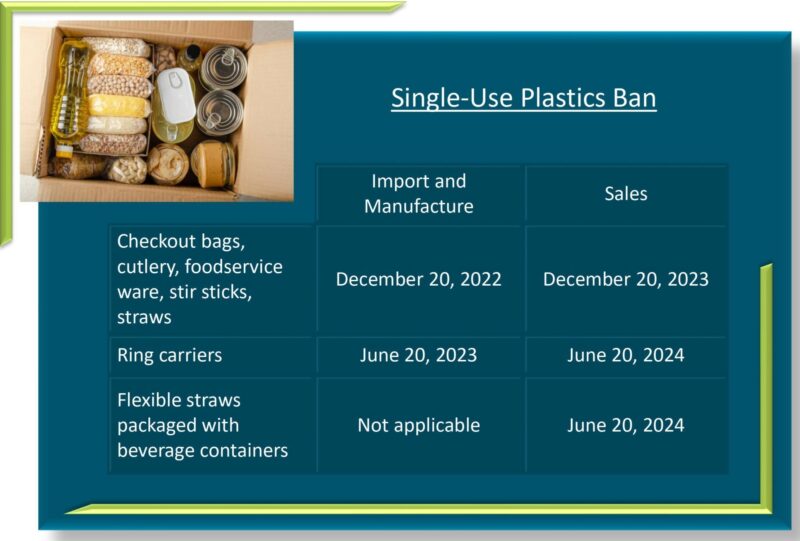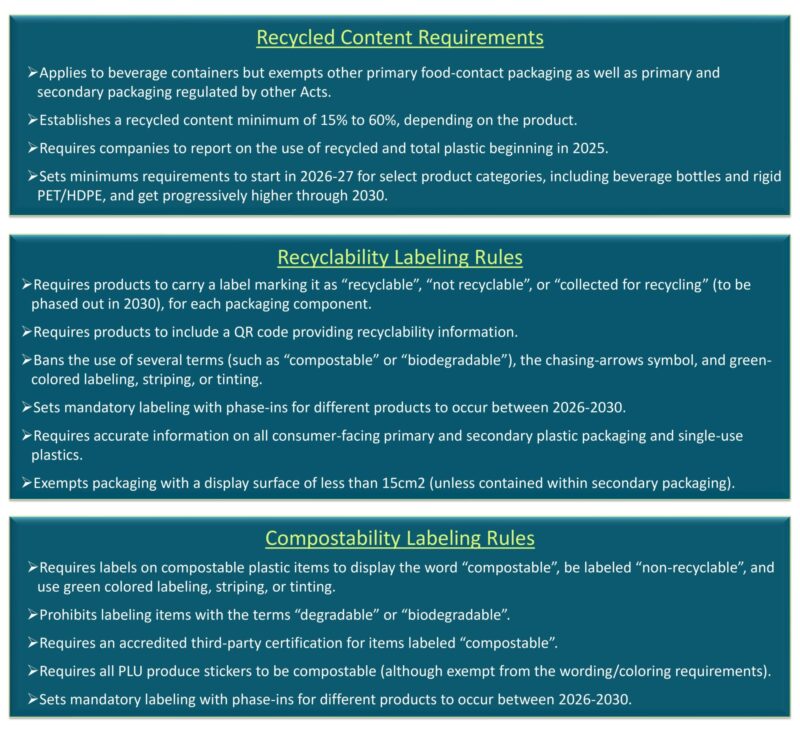A deep dive into Canada’s plastic reduction strategy highlights how your business may be affected by this important market’s particular mix of food packaging sustainability policies.
Plastic waste has become a widely recognized global environmental crisis, and the UN Food and Agriculture Organization (FAO) has estimated that food packaging accounts for over 10% of all plastic production. As countries legislate their way toward more sustainable food systems, they are including policies that will cut down on packaging waste. The resulting food and beverage packaging regulations are technical and complex, and vary country-to-country, making it hard for exporters to keep up. In a previous Global Insights article, we identified seven common policy pathways to improve packaging sustainability:
- Avoid plastic packaging
- Reduce excessive packaging
- Replace packaging materials with more environmentally friendly alternatives
- Recycle packaging
- Compost packaging and labels
- Reuse packaging
- Safety requirements for recycled materials
Here, we dive into Canada’s new plastics reduction strategy as an example of the array of policy tools adopted by one country and how these might apply to your business.
Every year, Canada produces over 3 million tons of plastic waste and almost half of that is in the form of packaging. To address this issue, Canada announced a plan to move toward a circular economy for plastics and developed a comprehensive Strategy on Zero Plastic Waste in 2018. Below are specific regulatory components of Canada’s plan, which aims to Avoid, Replace, Reduce, Recycle, and Compost.
Avoid & Replace
Phased in from 2022 until 2024, Canada’s Single-Use Plastics Prohibition Regulations ban the manufacture, import, and sale of several single-use plastic items (SUPs), as summarized in the chart below.

The ban targets “hard-to-recycle” plastics: extruded and expanded polystyrene foam, polyvinyl chloride, oxo-degradable plastics, and plastics containing certain black pigments. Affected foodservice items include clamshell containers, lidded containers, cartons, cups, plates, and bowls. Exemptions include flexible plastic packaging or wrapping for food that is ready to be consumed, plastic food service items containing frozen food that requires preparation before consumption (ex. baking, microwaving), and plastic trays without a lid wrapped in plastic film (typically used for raw meat/fish/vegetables).
Alongside this ban, Canada’s government developed a Guidance for Selecting Alternatives.
Reduce, Recycle, & Compost
Currently in the pipeline are two additional plastics policies. First, Canada is developing regulations that would establish minimum recycled content requirements for plastics and labeling rules for recyclability and compostability, detailed in the chart below. Consultation on the proposed Regulatory Framework Paper concluded in May and draft regulations are targeted for publication by the end of 2023, with the final regulation to be published before the end of 2024.

Second, Canada is developing a federal plastics registry, requiring producers to report on the plastics they place on the Canadian market. The registry is intended to support provincial extended producer responsibility (EPR) programs, which support recycling and encourage packaging reduction. Publication of the final regulation is expected before the end of 2024, with reporting responsibilities beginning as early as June 1, 2025. While exporters will not have a direct reporting obligation, importers may require that their suppliers collect and report packaging data for their products.
National Cohesiveness, but Global Variation
Canada’s efforts towards sustainability and packaging showcase how each country is likely to introduce an array of new sustainability legislation that impacts suppliers – directly and indirectly. While the Canadian government is seeking to develop an integrated and cohesive system of policy tools, for companies exporting to multiple markets, both the complexity and the likelihood that requirements will conflict across markets is multiplied. For example, markets including Canada may require minimum recycled content, while others may still restrict the use of these materials in food packaging in a way that makes it difficult to meet all requirements with a single packaging line. We will explore this challenge further in a future Global Insights article by focusing on a single policy pathway and comparing the various regulations chosen by different countries.
BCI monitors global regulatory announcements, draft proposals, and new implementations on these and other topics from around the world every day. If staying on top of these regulatory changes is a challenge for you, subscribe to a BCI Monitor!
For more on global export news, insights and information please visit Bryant Christie Inc’s website, sign up for our e-newsletter and follow us on LinkedIn and Twitter.
Canada’s efforts towards sustainability and packaging showcase how each country is likely to introduce an array of new sustainability legislation that impacts your business – directly and indirectly.

